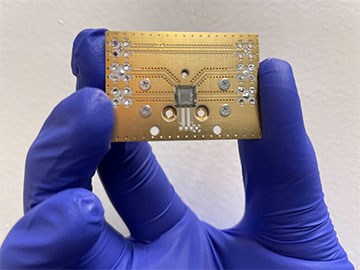
Scientists at the University of Chicago and Argonne National Laboratory, USA, have demonstrated qubit coherence times exceeding 5 seconds in chips made from silicon carbide, a CMOS-compatible material already used in a wide variety of applications. [Image: David Awschalom/University of Chicago]
The spins arising from defects in solid-state crystals are among the most promising type of quantum bit, or qubit, being developed today. In particular, those engineered from silicon carbide (SiC) offer the potential of wafer-scale, CMOS-compatible production. To date, however, it has not been possible to measure such spins deterministically via the process of single-shot readout.
Researchers in the United States have now shown how to do this by mapping the state of SiC spins to those of long-lived charges, and as result show they can keep the spins coherent for more than 5 seconds—a near eternity in the quantum world (Sci. Adv., doi: 10.1126/sciadv.abm5912). They reckon their technique could pave the way to long-range quantum communication and extremely precise quantum sensors.
Single transition problem
The work was carried out by David Awschalom and colleagues at the University of Chicago and Argonne National Laboratory, who created a double vacancy in a hexagonal crystal of SiC by removing single carbon and silicon atoms. The unpaired bonds from atoms surrounding the defect form a spin state that can be manipulated using laser beams and microwaves.
Initializing the qubit involves exciting it with a laser and allowing it to drop to its ground state, before applying microwaves to place it in a particular spin sub-level. Reading is then usually performed by pumping the qubit with a second laser beam at one of its optical resonances and registering the photons given off via photoluminescence.
The problem with this latter step is that pumping via a single transition can cause the qubit‘s spin to flip. This depopulates the spin sub-level before an adequate number of photons can be emitted, given limited collection efficiencies. The result is an inability to read out the qubit’s state with a single laser shot, which would, for example, render entanglement distribution too slow for the quantum networks of tomorrow.
Spin-to-charge conversion
One way to try and overcome this problem is to map the qubit‘s spin state onto a charge state—and then readout the former by exciting the latter. Until now, however, this “spin-to-charge conversion” has only been demonstrated using nitrogen-based vacancy centers in diamond.
Awschalom and colleagues show how to do a similar thing in silicon carbide by taking advantage of different levels of photoluminescence between the defect‘s neutral and charged states. Their multi-step scheme involves first initializing the vacancy in its neutral state using a relatively high-frequency laser pulse, before initializing the spin state and manipulating it with microwaves.
This lays the ground for the spin-to-charge conversion, which sees one laser pulse fired to induce a spin-selective optical transition and a second pulse with enough energy to then ionize the defect from the excited state without exciting any optical transitions in the process. The spin excitation, and with it the ionization, happens only if the spin is initially in is its ground state—spin-up—as opposed to either of its spin sub-levels—spin-down.
With the charge state dependent on the spin state, two lasers are then used to induce ground-to-excited transitions of all the qubit’s spin sub-levels to read out the charge state. Significant photoluminescence only occurs in the absence of ionization and therefore signifies that the qubit has been prepared in its spin-down state.
Achieving long coherence time
Carrying out this technique, the researchers found they could read out the spin state with 80% fidelity, giving them a high signal-to-noise ratio that in turn allowed them to measure long coherence times.
As they explain, in natural SiC interactions between the nuclei of silicon-29 and carbon-13, magnetic fluctuations from the interactions decohere the qubit‘s spin state. Their sample instead was engineered to minimize the amounts of these two isotopes. They then extended the coherence time still further by applying a series of microwave pulses to repeatedly decouple the qubit from sources of noise.
Applying over 16,000 pulses, the researchers obtained a maximum coherence time of 5.3 seconds. This, they point out, is more than two orders of magnitude longer than the previous best for SiC (which they themselves reported a little over a year ago). But they reckon they could do better still by using even more microwave pulses—given that they did not observe any saturation of the coherence time as they upped the pulse number. They add that their spin-to-charge conversion could be improved in a number of ways, such as by optimizing the laser wavelength needed to ionize the defect and by using polarized light to avoid unwanted stimulated emission.
Ultimately, Awschalom and colleagues reckon that their work could be exploited in the repeaters needed to extend quantum networks over long distances—the long coherence time reducing the error rates in repeaters’ memories. They say that more durable coherence could also benefit quantum sensing by allowing devices to accumulate additional phase and thereby increase their sensitivity to weak signals.
